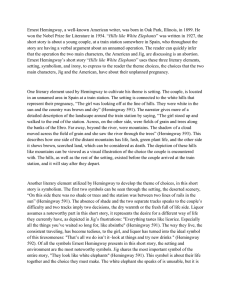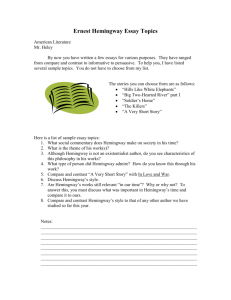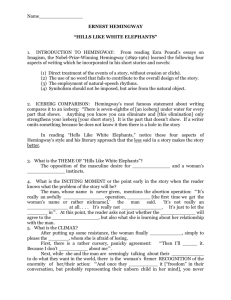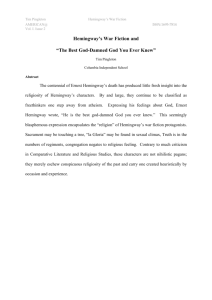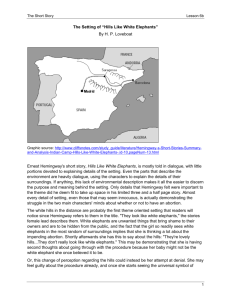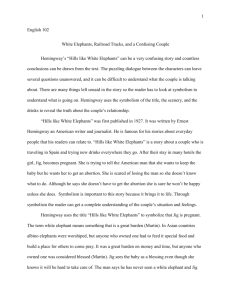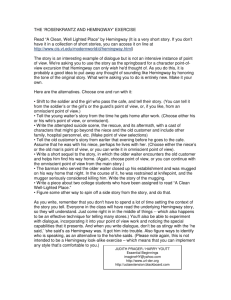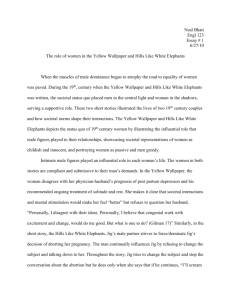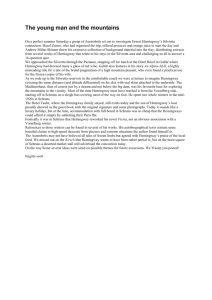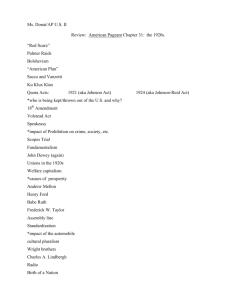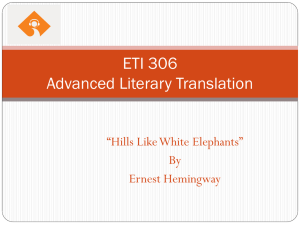Psychological Criticism of "Hills Like White Elephants" by Ernest
advertisement
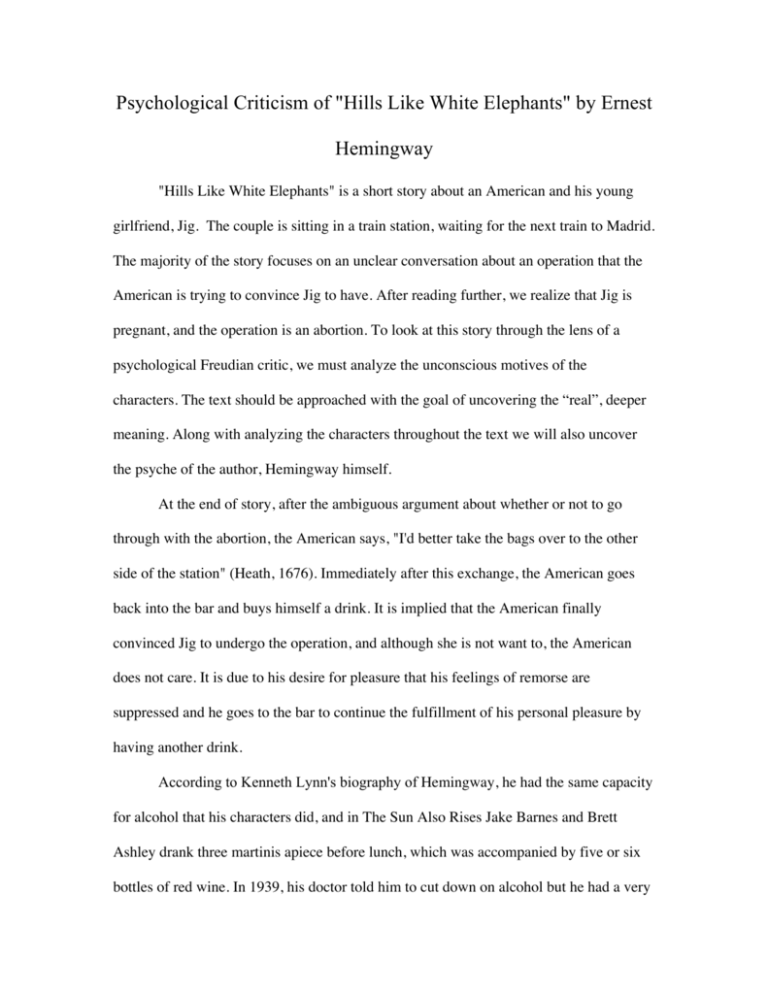
Psychological Criticism of "Hills Like White Elephants" by Ernest Hemingway "Hills Like White Elephants" is a short story about an American and his young girlfriend, Jig. The couple is sitting in a train station, waiting for the next train to Madrid. The majority of the story focuses on an unclear conversation about an operation that the American is trying to convince Jig to have. After reading further, we realize that Jig is pregnant, and the operation is an abortion. To look at this story through the lens of a psychological Freudian critic, we must analyze the unconscious motives of the characters. The text should be approached with the goal of uncovering the “real”, deeper meaning. Along with analyzing the characters throughout the text we will also uncover the psyche of the author, Hemingway himself. At the end of story, after the ambiguous argument about whether or not to go through with the abortion, the American says, "I'd better take the bags over to the other side of the station" (Heath, 1676). Immediately after this exchange, the American goes back into the bar and buys himself a drink. It is implied that the American finally convinced Jig to undergo the operation, and although she is not want to, the American does not care. It is due to his desire for pleasure that his feelings of remorse are suppressed and he goes to the bar to continue the fulfillment of his personal pleasure by having another drink. According to Kenneth Lynn's biography of Hemingway, he had the same capacity for alcohol that his characters did, and in The Sun Also Rises Jake Barnes and Brett Ashley drank three martinis apiece before lunch, which was accompanied by five or six bottles of red wine. In 1939, his doctor told him to cut down on alcohol but he had a very hard time doing so. He "tried to hold himself to three Scotches before dinner but he couldn't do it and, in 1940, he began breakfasting on tea and gin and swigging absinthe, whiskey, vodka and wine at various times during the day. He even let his boys drink hard liquor when one of them was only 10" (Unhooked). His alcoholism brought on many physical ailments and eventually led to his suicide at 62. The American sees the baby as an obstacle to his personal freedom. He says, "We could have all this… we can have the whole world... We can go everywhere... They haven't taken it away." To each of these statements, Jig replies, "No we can't" (Heath, 1675). Freud believed that "the id is always trying to satisfy its hunger for pleasure" (Theory 53). It is clear that the American's pleasure is in freedom, which is very stereotypical of an American, and he sees the baby as an obstacle to their personal freedom. It is trying to place the baby as the object of their relational problems. Freud goes on to say that the id "operates without any thought of consequences, anxiety, ethics, logic, precaution, or morality" (53). The topic of abortion, especially in the 1920's, was a major issue of morality, but this issue is never acknowledged. The id can be a very destructive force. In this situation, if the American were to be unrestrained, it would result in the loss of life. The use of the third person narrative in this story works as a great tool to look at both characters objectively. The thoughts of the characters are unknown and must be read into carefully through their dialogue and actions. The use of third-person reveals few facts about either character. The dialogue creates a feeling of awkwardness from the very beginning. The dialogue can be interpreted as a stereotypical conversation between male and female. There is a point in the story when Jig compares the hills to white elephants, but the American denies her poetic observation with his very rational response, "I've never seen one." This rational response suppresses Jig’s poetic observation and, once more, takes his place as the dominant male enforcing his dominance over the conversation. The symbol of the white elephant is obviously important because it is the title Hemingway chose for his story. Jig uses the metaphor of the hills across the valley looking like white elephants. The elephant could refer to the proverbial "elephant in the room," which is the baby. The baby is an obstacle that needs to be addressed and it is clear that they are in disagreement upon the way it should be addressed. Other physical surroundings are also metaphorical. The train tracks divide a barren area and a fertile valley. When the man moves the luggage to the "opposite side of the tracks" it symbolizes his dominance in convincing her to go through with the abortion. Another important symbol is the girl's name, Jig. The word jig is an outdated slang term for intercourse. The man using this word as her name represents the purely physical and sexual side of their relationship. He views her as a sexual object, or as he says "a fine time". At one point in the story, Jig asks the American for permission to order a drink. This could be insight into the inner workings of their relationship and show his dominance over her. The word 'jig' is also a tool used to measure whiskey. This goes back to how deeply rooted alcohol is into this story. Freud believed that "The artist... is an unstable personality who writes out of his own neuroses" (Theory 51). He believed that the artist's "work provides therapeutic insights into the nature of life not only for himself but also for those who read" (51). Hemingway is known for leaving character details out to allow the characters to speak for themselves. He leaves many details of his stories ambiguous to allow for readers to use their interpretation. This story reflects much of Hemingway's own personal character. He was married four different times, having three notable affairs, all of which led to new marriages. Hemingway had a clear problem with fidelity in his life, and this may be due to his unrestrained id. The American in this story has a lack or a fear of commitment much like Hemingway has shown that he has through his actions in his personal life. Using Hemingway’s literature and biography, Christopher D. Martin, a psychiatrist at Baylor College, believes that, "significant evidence exists to support the diagnoses of bipolar disorder, alcohol dependence, traumatic brain injury, and probable borderline symptoms and narcissistic personality traits" (Martin). Sexual misadventure is common in patients with bipolar type 1, so common in fact, that it would be rare for Hemingway to have not been suffering from sexual problems. The American idealizes the life of partying, drinking, and freedom, all of which proved to be priorities in Hemingway’s life. Many feminist critics would say that Hemingway is known for “othering” women, much like he does in this short story. It is unknown whether or not Hemingway was a misogynist, but many of his stories show slight evidence for this. This could be the reason he creates a dominant, American, male character who gets his way over his passive, innocent, naive girlfriend. His own personal male dominance could be shining through the character of the American. If we were to dive even further into Freud’s theories we could even apply his Oedipal complex into the framework of the story. The American could be displaying a fear of childbirth because of his subconscious fear of fatherhood. The American could have suppressed, subconscious feelings of envy toward his own father, much like Oedipus did, and this may be a reason why he is advocating the termination of the baby. His subconscious self-preservation is taking over and trying to prevent his child from “murdering” him. The story is also centered on alcohol. Alcohol is one of the focal points of "Hills like White Elephants". The story begins and ends with alcohol. The very first line of dialogue is "What should we drink?" (Heath, 1673). Throughout the story the couple is drinking and talking about drinking. This reflects Hemingway's struggle to get away from the bottle. Even when he tried, he could not limit his alcohol consumption. The story ends with the American going into the bar alone and buying himself a drink, and alcohol, among other causes, is what eventually led Hemingway’s end. Works Cited Curnutt, Kirk et.al. The Heath Anthology of American Literature. Belmont: Wadsworth Publishing, 2009. Dobie, Ann B. Theory into Practice An Introduction to Literacy Criticism. Boston: Heinle, 2008. Print. Martin, Christopher. "Ernest Hemingway: A Psychological Autopsy of a Suicide." Psychiatry: Interpersonal & Biological Processes 69.4 (2006): 351-61. Print. Waldron, Ann. "WRITERS AND ALCOHOL." Home page of LifeRing Secular Recovery. Web. 25 Feb. 2010. <http://www.unhooked.com/sep/writers.htm>.
